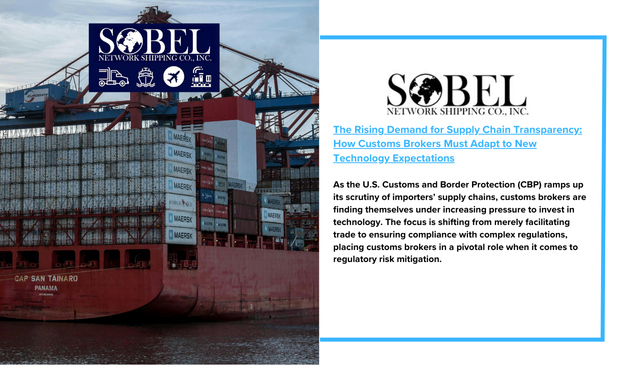As the U.S. Customs and Border Protection (CBP) ramps up its scrutiny of importers’ supply chains, customs brokers are finding themselves under increasing pressure to invest in technology. The focus is shifting from merely facilitating trade to ensuring compliance with complex regulations, placing customs brokers in a pivotal role when it comes to regulatory risk mitigation.
While the need for technology investments has always been present, CBP’s growing emphasis on the upstream supply chains of importers is turning this expectation into a concrete requirement. Brokers are now actively seeking out technology solutions to help their clients screen for potential compliance risks, such as forced labor, involvement with sanctioned entities, or more severe criminal activity.
The Push for Advanced Analytics and Compliance
“There’s a rising expectation that customs brokers employ advanced data analytics and technology as part of their duty to exercise reasonable care,” explains Amy Morgan, Vice President and Head of Trade Compliance at Altana, a software provider specializing in supply chain insights. According to Morgan, CBP has begun communicating a new “compliance paradigm” that requires product-level value chain visibility, making it harder for brokers to operate without advanced technology.
Yet, many customs brokers remain hesitant to invest in these tools, largely because there are no direct incentives or mandates for sharing insights with CBP. This reluctance may soon shift as expectations grow, but for now, supply chain transparency remains a competitive advantage rather than an industry standard.
Cindy Allen, CEO of compliance consultancy Trade Force Multiplier, highlights that the technology to screen clients and products already exists, but it’s not a universal requirement yet. “Customs brokers can screen their clients’ databases and products for compliance issues, offering value through visibility into potential problems like forced labor or intellectual property rights violations,” says Allen. This service is becoming an essential differentiator for brokers who want to stand out.
Understanding the Role of ‘Adverse Inference’
A key driver behind the push for greater supply chain transparency is the concept of “adverse inference” in trade compliance. Adverse inference refers to the penalties or restrictions an importer may face for failing to understand its supply chain. This principle has evolved significantly in recent years, requiring deeper knowledge of a product’s origin and manufacturing process.
“Historically, we didn’t focus too much on details like where cotton was grown or where aluminum was smelted,” says Ania Wierzbowska-Fuller, Director of Consulting and Regulatory Affairs at customs broker AN Deringer. “Now, importers need to map their entire supply chains down to the smallest components or raw materials to avoid penalties related to forced labor or other compliance issues.”
For customs brokers, the challenge lies in navigating the fine line between operational investment and offering value-added services to clients. While brokers aren’t legally required to have visibility into their clients’ supply chains, it is increasingly clear that their clients must. Providing tools to enable this level of transparency can give brokers a significant edge in the market.
Technology as a Competitive Advantage
A variety of supply chain platforms have emerged to meet this growing demand, offering solutions for supplier mapping and risk management. Companies like Altana, Mesur.io, Kharon, Interos, and Everstream Analytics provide tools to help customs brokers and logistics providers map their supply chains, identify risks, and ensure compliance. These platforms cater to both private and public sector clients, offering a range of insights into complex supply chains.
One of the obstacles to greater technology adoption stems from the historical relationship between U.S. customs officials and customs brokers. As a trade compliance veteran told the Journal of Commerce, “In the late ‘80s and early ‘90s, there was an adversarial relationship between brokers and customs, with brokers often seen as helping importers evade regulations.” Over the years, this view has shifted as brokers have become indispensable to global commerce, but some resistance to large-scale technological investment remains.
Looking Ahead: Deeper Supply Chain Visibility Expected
Despite these challenges, industry experts believe that the expectation for customs brokers to have deeper visibility into supply chains will only grow. “Brokers will eventually need to know their clients’ suppliers and potentially even the suppliers’ suppliers, especially in industries with high regulatory scrutiny like electronics, apparel, and food products,” says Morgan.
The level of insight required will vary depending on the industry, but in high-risk sectors such as pharmaceuticals and electronics, multiple tiers of the supply chain will likely need to be mapped. This transparency is crucial for meeting safety standards, labor practices, and intellectual property compliance.
As supply chain transparency becomes more critical to global trade, customs brokers will have to adopt technology solutions that not only help them stay compliant but also provide a competitive edge. The mandate for these investments is not official yet, but as compliance expectations evolve, it is becoming a necessity for brokers to stay ahead of the curve.


